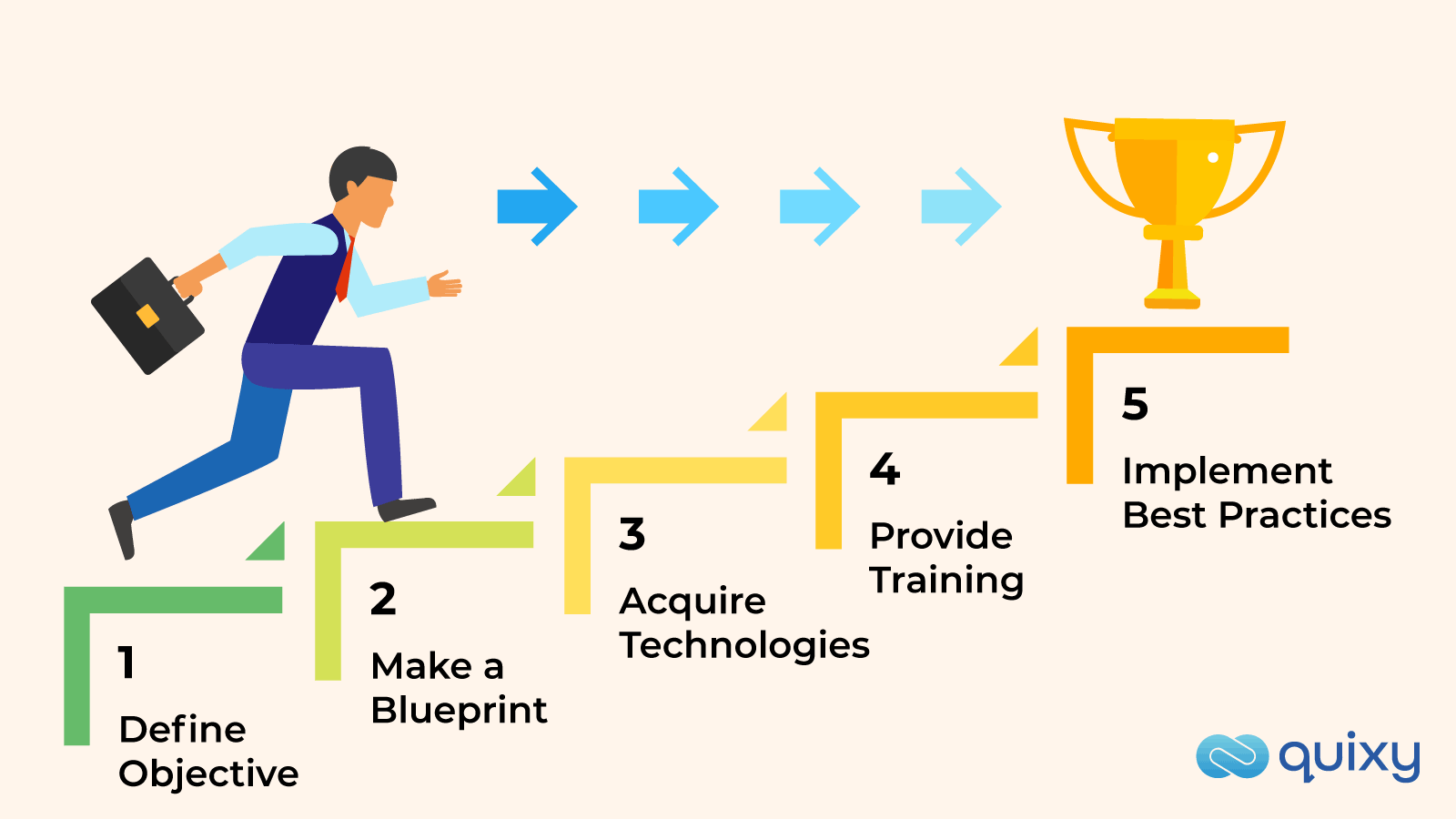
The last few years have been crucial in understanding a Digital workplace. Innovating a powerful and secure digital workplace strategy is even more compelling. While digital adoption was at its full pace, we were busy finding the correct track to implement digital workplace transformations. We were so busy providing flexibility and satisfaction to our global workforce. This results in our inability to keep up with the rapid expansion of the digital workplace.
Hence, it is necessary to deploy a convincing key digital workplace strategy to pick up that left pace.
With the successful adoption of the five key digital workplace steps, you will get to know the importance of building an effective digital workplace strategy before finally deploying your digital workplace. This will successfully strike a balance between employee satisfaction and corporate growth.
What is a Digital Workplace?
A survey states that 75% of the employees in the UK want to move forward with a hybrid workplace. Digital transformations make them productive. However, the matter of concern is to examine how to maintain this work culture successfully in the long term.
“A workplace that is a virtual and modernized ecosystem of technologies that enable employees to collaborate effectively is considered digital. The digital workplace is a suite of software that the workers utilize to connect, communicate, and collaborate. The purpose is to build the workplace beyond flexibility to upgrade connectivity and efficiency in the organization.”
This can effectively be done by deploying digital workplace strategies that will help in achieving desired goals.
What is a Digital Workplace Strategy?
An ideal digital workplace strategy:
- Streamlines and improve corporate processes.
- Encourages versatile working.
- Inspire collaboration.
- Upgrades employee engagement.
- Boosts communication and agility.
- Emphasize security.
- Inspire cooperation and
- Boost customer experience.
“ A digital workplace strategy is nothing but effective planning done before the implementation of new digital tools and technologies. There must be specific business strategies that enable employees to perform flexibly with effective collaboration to enhance productivity while keeping everything transparent.”
Also Read: Beginner’s Guide to Digital Workplace – All You Need to Know
5 Key Steps to Digital Workplace Strategy
Five powerful and paramount steps to shift to a digital workplace that businesses must implement to make their employees efficient and productive.

1. Describe a perfect Vision and direct objectives
Without any transparent insight, it is like leaping into the dark for your business. It will not be wrong if I say that blindly adopting any technology may fail for your long-term strategies. To achieve efficient outcomes, business objectives must be associated with digital workplace strategies.
Make sure to have crystal clear insights to modernize your work environment. Assure yourself that your decision of workplace digitization can improve work ethics involving productivity and enhanced employee engagement. Then work as a team to construct your workplace as per digital strategy ideas.
The success of your digital workforce strategy depends on cooperation with the communication, HR, and IT departments. The relationships might be crucial, but the connections with the most important business stakeholders should take precedence if you want to maximize your ROI.
2. Make a simple blueprint for your workplace strategy.
You have a clear picture that Workplace digitization is a combination of internal procedures, departmental organization, rewards, competencies, behavior, and culture. These are natural ideas that you must be already using; no need to start adopting a digital workplace framework from scratch.
In fact, you have to leverage your prior investments to build a modern and better business that covers all essentials.
Hence, you must prepare a handy blueprint for your digital workplace strategy that involves four specific layers that include technology, business drivers, control, and employees. The combination of these layers will offer a transparent path to make it certain that your digital workplace strategies are bringing effective outcomes.

3. Build a Layout and opt for the best Digital Tools and Technologies
With perfect insight, now it’s a turn to build a track for your workplace digitalization. This will trigger your transformed work culture with the collaboration of your employees. At this stage, you need to identify how to make this digital workplace platform fruitful for your business that offers employee satisfaction as well as productive output.
Hence, ask yourself and your employees a question, how can a workplace strategy enhance workers’ collaboration? And how can you improve connectivity to build a powerful business in the long run?
You need to understand the employees’ personas, which indicate the technology and tools that employees of individual departments require. This will set a baseline for reliable resources for your workforce. Building a smooth communication network and providing your hybrid as well as remote employees with the right collaboration tool can be a digital workplace strategy example.
Thus with the outcome of the debate, decide the digital workplace platform that you wish to inbuild for your digital workplace to make it effective.
Watch the related webinar: Overcome the Top 12 Digital Workplace Challenges
4. Provide Training for adopted Digital workplace platforms
Adapting new digital tools and technologies may suppress your employees and eventually can affect their productivity. You can overcome this issue by offering training, and, if required, by hiring a trainer to upskill them effectively.
As per Eric Geis, vice president of intellectual property at Cerner, when the medical technology company was looking to improve its software from C++ and C# programming languages to HTML5 and other web-friendly languages, it consider hiring a digital consultancy, PluralSights. This was its best decision to train its employees in new technologies and methodologies.
The company’s earlier attempts to upskill 26,000+ employees, who were dispersed in 30 international offices and across 10 U.S. locations, failed because they were too slow.
Geis also claims, “We couldn’t teach people rapidly enough, and the information quickly became outdated and stale.”
Therefore, it is necessary to train your employees with effective training to build your digital workplace successfully.
Also Read: The Role of Generative AI and ChatGPT in the Digital Workplace
5. Implement the Finest Methods
After setting up your digital workplace strategy and workplace toolbox, there is a need to fix up potential risk, governance, and compliance errors before the final deployment of the digital workplace toolbox. The businesses must also focus on creating a governance model that assists collaboration and connectivity while mitigating risks.
Elements of Implementing a Successful, agile, and robust digital workplace Strategy
Information Monitoring:
This enables you to identify potential risks for your business productivity, reputation, or any confidential data.
Policy Training:
This potentially trains your knowledge workers to deal with private pieces of information and also how to prevent the reputation of the organization.
Orchestrated Presence:
This allows you to arrange the flow of information among different channels and prevent the building of isolated groups.
Crisis Management:
This enables the organization to respond speedily during catastrophic situations.
As soon as you have established these four elements, you are all set to initiate your digital workplace with the most effective digital workplace strategies.
Besides this, profitable organizations, to outperform their competitors, implement a variety of digital strategy examples, ranging from leveraging new technology to capitalizing on shifting customer preferences.
Which actually seems a best practice!
Also Read: Mastering Digital Organization: A Guide to Thriving in a Tech-Driven World
How Quixy Empowers Your Digital Strategy
Rapid application development is at the heart of Quixy’s no-code platform, making it the ultimate tool for transforming your business into a digital powerhouse. With Quixy, you can craft a robust digital workplace strategy and enhance operational efficiency using the latest features.
- AI-Powered Assistance with AI Caddie: Leverage Quixy’s AI Caddie to accelerate artifact creation, automate repetitive tasks, and improve operational efficiency.
- Enhanced Data Visualization: Create stunning interactive reports with enhanced charting capabilities that bring your data to life, improving decision-making.
- ER Diagram View for Data Management: Simplifying complex data structures with the new Entity-Relationship (ER) Diagram View makes data organization and navigation effortless.
- Configurable Events for Precision: Gain complete control over business rules and validation triggers with Quixy’s Configurable Events, enhancing application efficiency and accuracy.
- Solution View 2.0 for Project Oversight: Manage and monitor projects effortlessly with Solution View 2.0, offering comprehensive insights and better control.
- Seamless Collaboration Tools: Enable hybrid and remote teams to work efficiently by integrating communication and collaboration tools within your digital workplace framework.
- Flexibility and Scalability: Adapt your workflows quickly as your business grows with Quixy’s customizable and scalable solutions.
Conclusion
At this point, you must have acquired a better realization of why to build digital workplace strategies prior to the final implementation of digital tools and technologies. As overall working is hybrid or remote, resources should exist to secure data transformation as well. Hence, organizations must also ensure a secure work environment using cybersecurity tools apart from focusing on employee engagement and business protocols. The five pillars can act as icing on the cake if implemented sequentially, associating with an employee-first policy. Further, it also helps you in attaining a balance among every essential digital strategy idea that needs to be focused on before final execution.
Quixy offers plenty of opportunities to develop a digitized workplace with a no-code business process management platform. Don’t miss out on the chance to elevate your processes. Take the first step and get started with Quixy today.
Frequently Asked Questions(FAQs)
Q. What is a digital workplace strategy?
A digital workplace strategy is a comprehensive plan for organizations to utilize digital tools and automation technologies to enhance productivity, collaboration, and communication within the workplace. It aims to create a cohesive & seamless digital ecosystem where employees can easily access and utilize the necessary tools and resources to work efficiently and effectively.
A well-designed digital workplace strategy can result in a more agile and responsive organization, streamlined operations, improved decision-making, and increased productivity and profitability.
Q. What is the digital workplace definition?
A digital workplace is a concept that refers to the collection of all the digital tools, platforms, and technologies that employees use to accomplish their work tasks and collaborate with others in a modern, digital environment. The digital workplace encompasses everything from traditional desktop computers and email applications to mobile devices, cloud-based software, and virtual collaboration tools, aiming to improve productivity, engagement, and efficiency across the organization. In short, it is a comprehensive strategy to transform the traditional office space into a modern, digital workspace that empowers employees to work smarter, faster, and more efficiently.
Q. What is digital business strategy?
Digital business strategy refers to a company’s set of plans, actions, and investments to leverage digital technologies and data to create new business models, increase efficiency and productivity, improve customer experience, and gain a competitive advantage. It involves using technology to transform how the organization operates, interacts with customers, and creates value for stakeholders. A corporate digital strategy may include implementing new digital platforms, leveraging data analytics and artificial intelligence, adopting new business models, developing new products and services, and enhancing the company’s digital capabilities.
Q. What is a digital workplace?
A digital workplace is a concept that refers to a virtual environment where employees can access and collaborate on work-related tools, data, and information through digital devices and platforms, regardless of their physical location or time zone.
Q. How do you create digital workplace strategy?
Creating a digital workplace strategy involves identifying the goals and objectives of the organization, assessing current digital capabilities, and developing a plan to leverage technology to enhance collaboration, productivity, and innovation within the workplace. This can involve selecting and implementing digital tools and platforms, establishing policies and procedures for their use, and providing training and support to employees. The digital strategy should be aligned with the overall business strategy and continuously reviewed and updated to ensure effectiveness.
Login
Please login to comment
0 Comments
Oldest
















